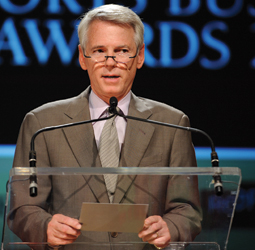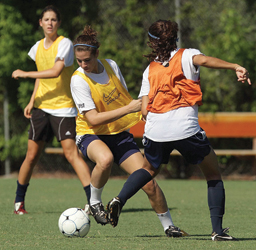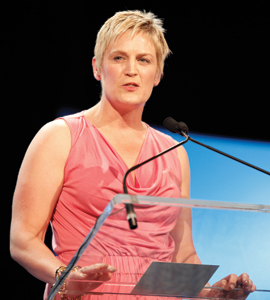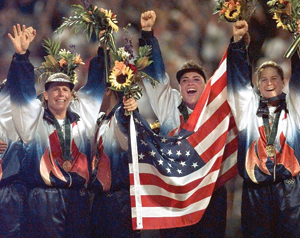Saturday marks the 40th anniversary of the enactment of the landmark federal legislation known as Title IX.
Made law as part of the broad-based Education Amendments of 1972, Title IX has become synonymous with gender equity in college sports — even though “athletics” is not part of the law’s formal wording. The resulting effects of Title IX have been, and continue to be, seen on playing fields and in boardrooms across the country and in organizations beyond just the NCAA and its universities.
But challenges remain; threats to the legacy of Title IX persist.
SportsBusiness Journal asked representatives from across the industry to share their thoughts on Title IX on the occasion of its 40th anniversary. We also received comments from readers of SportsBusiness Daily who shared with us their stories of how Title IX has affected them and, in some cases, their families.
Their words are presented here and on the pages that follow. Comments have been edited for clarity and brevity.
 |
Photo by: AP IMAGES
|
Joe Castiglione
Athletic Director,
University of Oklahoma
Perhaps the ongoing legacy of Title IX will be defined in different ways, but one thing is certain: It has created a residual wave of opportunity that was the dream its staunch proponents envisioned in 1972.
Opportunity has been and should always remain the enduring theme of Title IX. To truly comprehend just how many lives have been and will continue to be positively impacted by this legislation, we must extend our horizon beyond the courts, fields, pools, tracks and even the coaching arena. From journalism to athletic training to marketing and leadership opportunities — the list goes on and on — it’s impossible to quantify the exponential growth in potential career paths that Title IX played a role in expanding for both men and women. That beacon of ongoing opportunity continues to shine brightly with no need for gender differentiation. And ultimately, removing gender from the equation and creating opportunity was at the very core of the Title IX movement.
 |
Former Oklahoma athletics official Marita Hynes helped make the NCAA Women’s College World Series what it is today, Castiglione says, and is among the Title IX trailblazers who helped lead the way.
Photo by: AP IMAGES
|
For two generations, the watershed legislation known as Title IX has also fostered the development of “pioneers” who have made an immeasurable impact on campuses and communities across our country. If Title IX is delineated by opportunity, it has been personified by exceptional leaders who truly transcend sport. While many others could also be mentioned, who couldn’t help but beam when we witnessed Pat Summitt receiving the Presidential Medal of Freedom? There are other poignant stories like Pat’s that may never have unfolded had it not been for Title IX.
At the University of Oklahoma, Marita Hynes served as a similar trailblazer, ushering women’s athletics into the modern era on our campus. Marita’s vision, passion and relentless efforts helped elevate opportunity and competition to a national stage for female student athletes. Without her, the NCAA Women’s College World Series may have never existed as we know it today. She should take great pride that the University of Oklahoma program she built from scratch reached the Women’s College World Series for a seventh time in 2012.
For our future leaders, our ultimate challenge as stewards of Title IX is remaining steadfast in our commitment to providing new opportunities to inspire academic achievement, athletic excellence and career development over the next 40 years. Pat Summitt and Marita Hynes would expect nothing less, and nor should we as Americans.
| A few years ago, while watching a tennis tournament on television, a young female tennis star was asked about the impact of Title IX on her life. She answered that she didn’t know what Title IX was. At first, I was taken aback by the comment because Title IX has been a huge influence on my life. After thinking about it, I asked myself, "Isn't that a testament to the effectiveness |
|
of Title IX, because in her life, she never experienced inequality while pursuing her sport?” I immediately went from astounded to inspired.
Jeanie Buss
Executive Vice President,
Business Operations
Los Angeles Lakers
|
|
 |
Photo by: PATRICK E. MCCARTHY
|
Donna Lopiano
President,
Sports Management Resources
Former CEO,
Women’s Sports Foundation
The Title IX legacy to date is impressive: 3.1 million girls participating in high school sports, 300,000 girls playing varsity sports in junior and senior colleges and universities, and over 15 million girls participating in youth sports, representing 35 percent to 43 percent of all participants in these categories, up from 5 percent to 8 percent of all participants 40 years ago. These gains among girls and young adults have resulted in increased physical activity in adult women and benefits to females that include lower risks for breast cancer, heart disease, teen pregnancy, smoking, drug use, obesity and other health conditions, and greater gains in high school grades, high school graduation, college matriculation, employment and career success compared to nonparticipants.
 |
Despite greater participation at the high school level, inequalities remain.
Photo by: ICON SMI
|
Title IX has contributed to two generations of women who are more confident, have higher self-esteem, are more resilient, and possess stronger self-images than their mothers and grandmothers. We are now seeing the first generation of mothers coaching their sons and daughters, and millions of fathers as likely to be throwing or kicking a ball around in the backyard with their sons as their daughters.
But we are still only halfway to equity. Too many people don’t realize that girls and women are still being short-changed in the vast majority of sports programs, receiving fewer opportunities to play, less funding, less promotions and generally still being treated as second-class citizens in many respects. Despite the still significant participation gap (1.3 million sport opportunities at the high school level alone), schools and colleges are annually adding more new sports opportunities for boys than they are for girls. Eighty percent of all coaches and sport administrators are male, with males still holding the most prestigious and highest-paid positions resulting in the absence of persistent strong voices in support of equality. The sport culture is still male-dominated and susceptible to backsliding at any moment whenever the public stops looking. Men’s minor sports programs are being eliminated to provide more resources to fuel the collegiate arms race in football and men’s basketball and diminishing resources that could be used for continued progress on gender equity. Thus, failure to (1) wisely spend limited athletics resources, (2) continue progress toward equitable participation and treatment, and (3) commit to opening sport employment doors for our daughters are still the greatest threats to a better future.
| In swimming, the international sign for “Move over; I’m faster and need to pass” is to gently touch the feet of the swimmer in front of you. I started swimming competitively when I was 7 years old on a mixed-gender YMCA swim team and would “touch feet” all the time. I never thought twice about if the person in front of me was a boy or girl. I just needed to pass them because I was faster.
I went on to row at Columbia, where the men’s and women’s teams were treated exactly the same. We shared a boathouse with the men, went on the same training trip where we took the same bus and stayed in the same hotel, and even raced them from time to time for boathouse bragging rights. Naturally, the men on the Columbia heavyweight rowing team were a bit harder for me to beat than the 7-year-old boys at the YMCA, but there was still a bit of “feet
|
|
touching” from time to time.
Since I have started working in the sports industry, I have set my sights on lofty goals like being commissioner of the NFL or the general manager of an MLB team. Not once have I ever stopped to think about how my being a woman could hinder me in my dreams. With the progression of Title IX and pioneers like Kim Ng and Val Ackerman going where no woman has gone before, I foresee women in this generation “touching the feet” of men in the industry, not thinking twice about whether they are male or female, but just because they are faster and need to pass.
Meredith Mead
Student, Masters in
Sports Management
Columbia University
|
|
 |
Photo by: JOHN PAUL FILO / CBS
|
LeslieAnne Wade
Managing Partner,
Wade Media Management
Executive for Business Development,
Faldo Enterprises
Former SVP, Communications,
CBS Sports
Seems we take it all for granted now. Why wouldn’t we work and play equally with equal opportunity and possibility? It’s most logical and fair and clear in 2012, when so many of us have done so many special and important things in the athletic arena and in the business of sports. But for those of us old enough to remember, or thoughtful enough to truly appreciate, Title IX and the smart and brave women who stood on its platform presented the first real chance many of us had to pursue any dream. It broadened our imagination and our self-belief in addition to our opportunity to play.
While we recognize that Title IX represented broader equality, it’s no surprise that it was the women in athletics and the women of sports who challenged the limits. It began with the simplest request for equal participation, and in that request, women in athletics personified Title IX in its boldest light. Where in the world would we be without the words and actions of Billie Jean King? Her athletic biography is well documented, as was her match versus Bobby Riggs — which was certainly one of the most significant cultural events to influence our time. But as I bump into her here and there today, as I follow her on Twitter or share her true celebration of the new victories for women, I wonder whether so many of us take it all for granted?
 |
Billie Jean King’s words and actions allowed young women to look at themselves differently.
Photo by: SHANA WITTENWYLER
|
If you are lucky enough to attend an event with Billie Jean — many of which celebrate a victory for equality — she, the most recognized female athlete of our time, walks among the tables with outstretched hand and enthusiasm: “Hi, I’m Billie Jean. Thanks for being here.”
Well, we are here. And we are here in no small part due to her influence and effort on behalf of all of us.
While I grew up in the immediate wake of Title IX, among the first little girls with the opportunity to play Little League, it was the women who walked through the doors in front of me who held it open. And through that open door I could dream of a career in athletics and opportunity through sports and never question, “Will I be allowed? May I play, too?” The significance of being picked for the team and given the chance to fully explore our possibility in athletics impacted so many of us and eventually even those who hire in the big business of sports and beyond. That is the legacy. We were simply looked at differently and we looked at ourselves differently forever.
We simply cannot take this for granted. The danger is that we would ever forget those who walked before us or forget to hold the door for those behind. There is genuine pressure in preserving the compliance and opportunity of Title IX through awareness, but as the same great Billie Jean has said often and as such inspiration, “Pressure is a privilege.” I’ve been so privileged to have the opportunity presented by Title IX, to grow up in the climate of change. In gratitude and with pretty clear memory of those transitional days, I encourage the many dreams of my own daughter and support the limitless possibility for all girls — which began for so many of us with the simple invitation and inspiration to play.
| I’ve taught at Georgetown University for the past seven years. Each year, in the Sports Marketing Strategy course I teach in the undergraduate business school, at least 50 percent of my female students are student athletes. They play lacrosse, soccer, softball, volleyball, track and field, etc. I know that many of them don’t realize that if it weren’t for the pioneers that did so much to lay the groundwork for Title IX, they would not have the luxury of being able to play collegiate sports.
From being friends with many of the most influential and historic female sports figures to managing strategic sports partnerships with leading female
|
|
organizations to mentoring a number of professional female athletes to teaching female student athletes, I’ve seen the powerful impact of Title IX. And Title IX will continue to have a strong impact on young girls and women as we continue to fight child obesity. That will be another key legacy of one of the important pieces of legislation in the last half-century.
Jimmy Lynn
Managing Partner,
JLynn Associates
Former Vice President,
Strategic Development and Partnerships, AOL
|
|
 |
Photo by: ROXXE IRELAND
|
Sean McManus
Chairman,
CBS Sports
Though the original statute had no explicit mention of sports, since its passing into law in 1972, Title IX has become best known for its impact on leveling the playing field for young women in high school and collegiate athletics. The opportunities that it created, the doors it helped open and the positive effects it has had on generations of girls is its lasting legacy. Throughout the past 40 years, leagues were formed, tournaments created and champions were born. There is no doubt of the major role that Title IX played when one looks
 |
Title IX is present in great U.S. women’s sports moments such as the 1999 World Cup victory.
Photo by: GETTY IMAGES
|
back on the indelible image of Brandi Chastain celebrating the 1999 World Cup victory or the creation of the WNBA.
Title IX not only gave young women a level playing field and the opportunity to participate in athletics on a variety of levels, but through participation, it helped them develop self-confidence and a positive self-image to succeed as they go through life. Most importantly, it allowed young girls to dream big and believe that they could achieve greatness.
As Title IX turns 40 in a hard economic environment, the challenge is to continue to create equal opportunities for both women and men, as participation in athletics is important and valuable for everyone. Compliance has always been an issue across all levels. We need to make sure that schools and colleges are giving young girls and young women the opportunity to play. As we have seen over the past four decades, when girls start playing sports at a young age, the benefits last a lifetime.
| Years after Title IX was enacted, I attended the 1996 Olympic Games in Atlanta. Women’s team sports took center stage featuring athletes who represented the first wave of Title IX beneficiaries. I was fortunate to go to the softball, soccer and basketball gold-medal games, an experience I’ll never forget. And it was at the women’s basketball championship game when I had an epiphany: Why not branch out, go out on my own … and specialize in women’s sports management and marketing? Stars & Strategies, my consulting firm, in some measure pays homage to the wonder that is Title IX, as I went on to devote the next chapter of my career to helping female
|
|
athletes pursue endeavors off the field or court.
It means the world to me that my young granddaughter will be able to follow her sports dreams on a much grander scale than I. She and her friends have a limitless road ahead of them, thanks to the myriad advocates who raised their voices, made the case for gender equity and pushed those in power to level the proverbial playing field.
Sue Rodin
President, Stars & Strategies
Founder and Chair Emerita,
Women in Sports and Events
|
|
 |
| Photo by: WISE |
Kathleen Francis
National Chair and President,
Women in Sports and Events
The impact of Title IX on women’s sports participation is well-documented, and the benefits of playing sports have been extolled by many successful businesswomen. But while Title IX opened the doors for generations of girls to play sports and advance personally and professionally, focusing solely on this result marginalizes its broader impact. By mandating women be treated equally at federally funded educational institutions, Title IX gave women protection against harassment and discrimination. It provided greater choice and access to athletics, course offerings and financial resources. Women now had access to financial aid, athletic and academic scholarships, and expanded choice to classes traditionally the domain of men: accounting, finance, science and engineering, among others.
 |
Getting the chance to compete has helped generations of women succeed beyond the field of play.
Photo by: NEWSCOM |
Currently, women in sports hold positions in all disciplines at all levels, and because of Title IX, many of us entered with a confidence and unique understanding gleaned from playing in the schoolyard and up to the highest professional levels. However, as Kim Williams, COO of NFL Network and a student athlete herself, said to me recently, “An affinity and skill in sport may provide intangible benefits but it cannot trump functional skill.” And herein lies the most important legacy of this legislation: Title IX afforded us the equal right to develop the functional expertise in our field of choice and the financial means to do so. It gave women the benefit of choice and the opportunity to succeed, both on and off the field.
But today, the legislation that sent legions of girls out of the house and onto the field is being threatened by an economic reality: the loss of physical education and public park programming. This early exposure to sports allowed young girls to derive the intangible benefits of play and better positioned them to pursue athletic and academic scholarships as a gateway to further their education and careers. The loss of this critical programming threatens our personal gains and how we engage with sports — both women’s and men’s — from grassroots to the highest levels. So the most enumerated aspect of Title IX — demand for a level playing field — may fall victim to a lack of play, something none of us can afford.
| Born in 1980, I am part of the Title IX generation. As a recruited athlete, I had the privilege of attending the University of Pennsylvania and played on the first team in school history to go to the NCAA Division I women’s soccer tournament. I can honestly say that I haven’t once felt limited by my gender in either my playing career or my professional one.
I am often asked what it is like to be a female in the sports industry, and I must admit that I find the question puzzling. I haven’t found it difficult to work in sports
|
|
because I am judged by the same criteria as my male counterparts: success. I suppose, since the question is still posed, our perceptions still need to be addressed. One day, a woman in the sports business won’t be thought of as unique. Until then, I can’t begin to express my gratitude to the women who led the way.
Leigh Castergine
Vice President,
Ticket Sales and Services
New York Mets
|
|
 |
Photo by: TONY FLOREZ PHOTOGRAPHY
|
Judy Sweet
Co-director,
Alliance of Women Coaches
Former president, NCAA
Former athletic director,
UC San Diego
Title IX has been the golden key that has opened the door for equal opportunity for all. The most important outcomes of this landmark legislation revolve around choices that, because of Title IX, can become reality: educational career paths and athletic participation. Prior to the passage of Title IX, women had limited career choices (to be a teacher, nurse or secretary) and were not even admitted to several universities in the state of Virginia and elsewhere because of their gender. Similarly, girls and women had few, if any, opportunities on the sports fields.
Today, career choices are varied and plentiful, and athletic opportunities are significantly improved. Young girls now have role models: lawyers, doctors, engineers, architects, CEOs, astronauts and athletes. They can dream big dreams with the potential of making those dreams come true.
In celebrating this special anniversary, we also should recognize that our work is not done. We need to continue to educate, to present facts to erase the misunderstandings and myths surrounding Title IX’s impact on men’s sports, to help women understand their rights, and to no longer accept excuses for not fully meeting both our legal and moral responsibilities to comply with this landmark piece of legislation. With all the public support for Title IX, there is an unfortunate misunderstanding of the law, and too often, Title IX is blamed for decisions made by university administrators to reduce opportunities for men. There is nothing in Title IX that suggests such action, and in fact, Title IX is about providing opportunities, not taking them away. The goal should be to increase opportunities and support for the under-represented gender in order to achieve gender equity. The reality is that opportunities overall for both genders have increased in the last 40 years. While some sports have shown a decline in sponsorship (men’s and women’s), other sports have been added, resulting in more male and female participants than ever. It’s important that we provide accurate information on the law, educate future generations, and make sure that our sons and daughters have equal access, opportunities, support and benefits.
| My first experience with organized sports was playing on a co-ed soccer team at age 5, something that may not have been possible without the enactment of Title IX legislation. Title IX allowed nearly 10 million girls to join once-boy-dominated Little League baseball teams over the past 40 years, and this co-ed soccer league was my first opportunity to play with the boys. I was fortunate to live in a community that had an excellent recreation council for both boys and girls, which allowed me to play just about every sport imaginable over the course of my childhood — an experience that not only benefited me physically and mentally, but also taught me important life lessons about teamwork and sportsmanship. By the time I entered high school in 1992, I had been playing soccer, basketball and lacrosse with some of the same girls since elementary school. Playing these sports gave me an invaluable experience that has produced lifelong friendships.
In 1959, Kelly Post Lacrosse — the
|
|
country’s oldest youth lacrosse program — was founded in my community [Towson, Md.]. Approximately 30 years later, my older sisters were part of the inaugural Kelly Post girls’ lacrosse team. There’s no doubt that Title IX played a role in the start of women’s lacrosse in my community and helped pave the way for one of my sisters to play in college.
Title IX continues to impact my own family today. I have a toddler who loves to play ball and a husband who loves sports. Playing sports is something we can all do together, and I like to think that as a result of playing sports my entire life, I can teach my son to play catch or shoot hoops just as well as his dad can. Ultimately, my hope is that Title IX’s lasting legacy will provide my nieces and any daughters I may have with the same opportunities in sports that are available to males, whether on youth, college or professional platforms.
Meghann Malone
Marketing Manager
IMRE Sports
|
|
 |
Photo by: SHANA WITTENWYLER
|
Molly Solomon
Coordinating Producer,
NBC Olympics
Executive Producer,
Golf Channel
I remember the adrenaline. Night after night in the International Broadcast Center, my NBC colleagues and I watched small black-and-white monitors from venues across the state as the women of the U.S. teams did extraordinary things. Patriotism surged; fists pumped in control rooms; the national anthem was played to swelling receptions in Athens, Columbus and downtown Atlanta.
It was the 1996 Summer Olympics. To me, Title IX came of age during a four-night stretch of amazing success by America’s female athletes: the U.S. softball and soccer teams making their Olympic debut and winning gold, galvanizing the nation, followed by the U.S. women’s basketball team doing the same and reminding us that hoops was an American game. The groundbreaking momentum didn’t stop there: The Atlanta Olympic successes prompted the launching of three professional leagues in the U.S. in subsequent years.
 |
Solomon watched as the U.S. women’s softball team and others won gold in 1996.
Photo by: AP IMAGES
|
And the phone started ringing at our New York headquarters. Viewers wanted to see more of these compelling athletes on NBC’s Olympic coverage.
But for me, the legacy is also personal. The favorite part of my job producing Olympics television coverage is the strong female role models I encounter daily. I remain in awe of those who came before me and remain prominent fixtures in the Olympic movement, determined to move women’s sports forward — trailblazers such as Donna de Varona, Ann Meyers and Cynthia Potter. That group helped spawn a modern generation of empowered athletes — gold-medal winners such as Dot Richardson, Lisa Leslie, Brandi Chastain and Julie Foudy — contemporaries of mine who doggedly respect their forebears yet at the same time are mindful of the example they are setting for tomorrow’s athletes.
That includes my two daughters, Alex and Maddy, who are just beginning to experience the wonderful elixir that is Saturday morning soccer games and the feeling of proudly slipping on a team jersey. Their world is different, thanks to Title IX. They will never have to wonder if they will have the opportunity to participate. They simply can follow their athletic dreams.
















